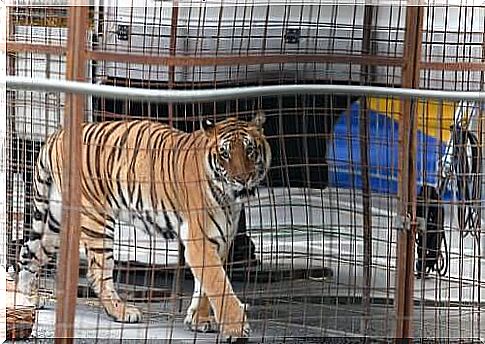The Most Common Diseases Of Wild Cats In Captivity

Wild cats form a diverse group of carnivorous animals, which range from small cats – from the genus Felis – to large cats – from the genera Panthera, Neofelis and Acinonyx . In this article, we’ll show you what are the most common diseases of these wild cats in captivity.
Infectious diseases of wild cats in captivity
rhinotracheitis
All felines are sensitive to feline rhinotracheitis. This is a very contagious disease, caused by a herpesvirus, which occurs similarly to what happens to domestic cats. That is, like an acute upper respiratory infection.
Clinical signs include nasal discharge with mucus or pus, conjunctivitis, and keratitis. They usually disappear after 14-28 days, unless there is a complication of bacterial disease. If it affects very young animals, it can be serious and intensive treatment may be needed for recovery.
calicivirus
Again, this is a very contagious virus, this time causing sneezing, runny nose and eyes, and mouth ulcers. It is sometimes deadly, especially if the lungs become infected, but uncomplicated cases usually resolve within 15 days.

Panleukopenia
Panleukopenia is an acute disease that causes anorexia, depression, vomiting, dehydration and diarrhea. It is a very contagious viral infection, transmitted by direct contact. Furthermore, the virus remains infectious for a long time in the environment.
Although not very common in wild cats, it does occur in some cases, and the problem arises when puppies become infected. A puppy with panleukopenia develops central nervous system problems.
Feline infectious peritonitis
The cats most likely to suffer from the problem are cheetahs. Therefore, it is necessary to avoid exposure to this coronavirus, especially avoiding contact with infected animals.
canine distemper
It is a paramyxovirus, which causes a fatal disease in wild cats that have had contact with infected dogs. Those who do not die remain subclinical carriers throughout their lives.

Leukemia in wild cats in captivity
Although it is a disease that is always diagnosed in domestic cats, it has also been described in wild cats. It usually causes signs of immunodeficiency. Typically, zoos maintain a population-negative policy towards this virus.
HIV in wild cats in captivity
Several retroviruses causing this disease have been described in wild cats, most of them related to the virus that causes it in cats. Symptoms vary and range from retinal problems to gingivitis or neurological disorders.
papillomavirus
It has been described in panthers, wild cats, lions, leopards, etc. Generally, each has been infected with a species-specific papillomavirus.
Symptoms include skin and mouth lesions. Some even worsen and cause tumors that can lead to the animal’s death.
Other diseases of wild cats in captivity
bacterial gastritis
Helicobacter spp. it is the causative agent of this disease that affects, above all, cheetahs. Symptoms include chronic vomiting, stomach ulcers, weight loss, anorexia and malaise.
bovine spongiform encephalopathy
This disease is known worldwide as ‘mad cow disease’. It has been described in populations of European felids that were fed on the corpses of prion-affected cows.
Dermatophytosis in wild cats in captivity
It is a parasitic disease caused by a dermatophyte fungus, usually Microsporum canis. Symptoms include hair loss, alopecia, skin redness, skin thickening and breakage, etc. Alopecia is most evident in the ears, limbs or neck, although it can also be generalized.









